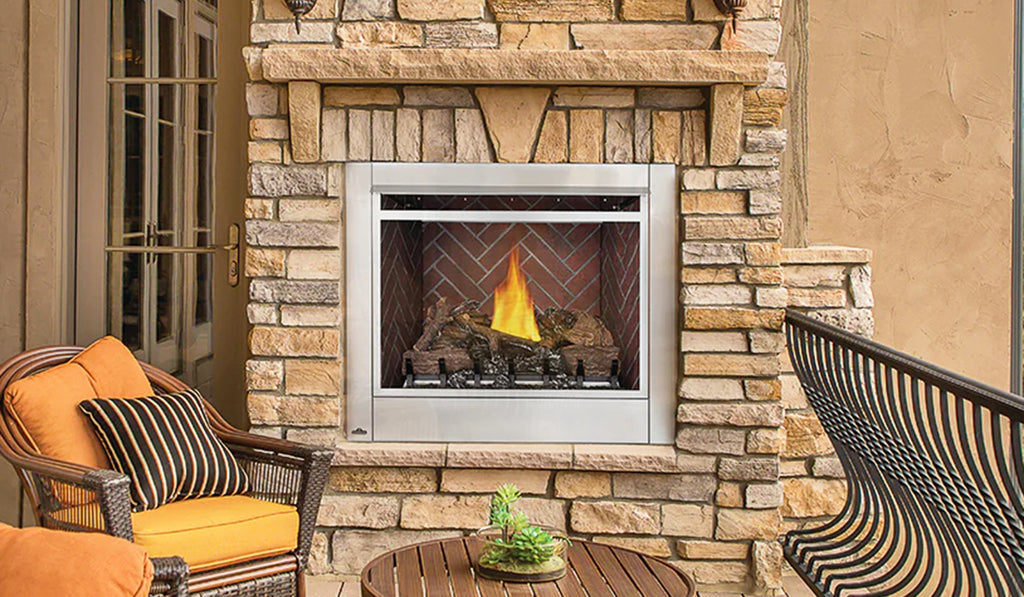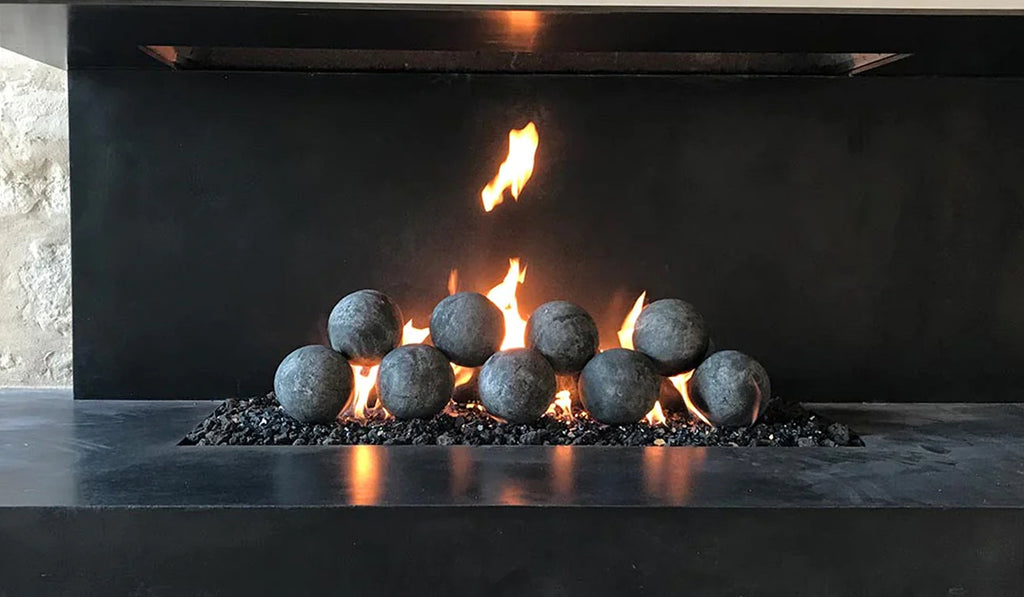Gas Fireplace Buying Guide
There’s nothing better than a cozy fire on a cold winter evening. Unless it’s punctuated with wood hauling, flying sparks, the need to clean up ashes. Reclaim the charm of a fireplace with gas.
A gas fireplace offers greater freedom, flexibility, and features for your modern life but still has the warmth and ambiance of a wood-burning fireplace. Come with us as we explore all the ins and outs of gas fireplaces and what you should be thinking about before you make a final decision.

Fuel
There are three fuel options when it comes to fireplaces in this category: natural gas, propane, and ethanol gel. Here’s a closer look at each.
Natural Gas
The most popular fossil fuel, natural gas is commonly found in houses as a source of cooking and heating. If you are already hooked up to natural gas, adding a natural gas fireplace will give you instant heat and ambiance with a touch of a button.
It creates very little emission when burned and creates no soot or ash.
Propane
Propane is compressed petroleum gas and is a liquid. It can be used for heating, cooking, and all the same things as natural gas. It’s a great option for a fireplace and can also be installed with an on/off switch.
It is considered a green fuel and produces little to no emissions. It doesn’t create any residue, soot, or ash.
Ethanol Gel
Gel ethanol is an alcohol-based fuel; the same type of alcohol found in alcoholic beverages but in a gel form. It is often added to gasoline. Many fireplaces and camp stoves use the gel form of ethanol. It does not burn as intensely as liquid fuels and the flames are smaller.
It doesn’t create soot or ash but does leave behind some residue.
Efficiency & Cost
The efficiency of your gas fireplace relies on the fuel type you choose. Gas is a popular choice for the fireplace because it is more efficient than electricity and more environmentally friendly than burning wood.
Efficiency is directly related to cost, as you will use less of an efficient fuel than its less efficient counterparts.
Here’s the run down.
Natural Gas
With a 92% efficiency rate, natural gas produces more energy (heat) than any other fossil fuel. It does a better job at converting fuel to heat than many other forms of fuel.
The American Gas Association said that in 2022 households that used natural gas for cooking, heating, and clothes drying saved an average of more than $1000 per year compared to homes using electricity.
Propane
Propane has a 93% efficiency rate. It delivers more BTUs (a measurement of heat output) than natural gas. It also burns more slowly than natural gas so less is used in the same amount of time. However, it is less popular than natural gas and therefore less available. It must be stored in a tank outside your home whereas natural gas can be piped in.
Propane is delivered to your home and pumped into a tank. Its cost is by the gallon and can be comparable in price to gasoline. Propane’s incredible efficiency does make it one of the most efficient fuels available and therefore costs less annually than many other forms of fuel.
Ethanol Gel
The benefit of ethanol gel is its efficiency and environmental friendliness. It is a very clean, slow burning fuel but doesn’t create as much heat as other fuels.
The efficiency of ethanol gel depends on how you use your fireplace. If you live in a warm climate where you don’t need as much heat as in a cold environment, this might be a good way to go. If you live in a cold environment, you might end up using more fuel to get the same heat output as other fuels.

Health
Health is a major concern when it comes to fireplaces. Smoke, carbon monoxide, and other pollutants are ever present. Gas fireplaces are far healthier than their former counterparts. Here’s a closer look at health factors of gas fireplaces.
Natural Gas
Natural Gas is a clean burning fuel source. It does release carbon dioxide and water when burned. The United States Energy Information Administration says about 117 pounds of carbon dioxide per million BTU are produced by natural gas. It does also produce a miniscule amount of carbon monoxide. Keeping your fireplace in good repair and using according to manufacturer's instructions will keep your fireplace virtually risk free. However, it is recommended that you keep a working carbon monoxide detector in your home as all gas appliances pose a small risk.
Propane
Non-toxic propane is very clean burning and non-carcinogenic. According to the EPA, propane fireplaces emit 135 pounds of carbon dioxide per million BTU and a miniscule amount of carbon monoxide. It is recommended that you place a carbon monoxide detector in your home if you have any gas-powered appliances, even though the risk is low.
Ethanol Gel
Another clean burning fuel, ethanol does not emit toxic fumes. It does not produce carbon monoxide unless combustion occurs at too high or too low of a temperature. Most fireplaces are designed to encourage combustion at the ideal temperature. However, it is recommended that you keep a carbon monoxide detector in your home.
Types
Gas fireplaces come in several different types. Some can slide into an existing firebox. Others can be recessed into a wall. Maybe you prefer a simple faux log set or some fireballs. You might opt for a more contemporary look and try different media like lava rock, stones, or glass and forego the log look entirely.
Inserts
The gas fireplace insert is made to be inserted into the wall. You can sometimes use an existing firebox that you’re converting from a wood-burning fireplace, or you can build a housing for the fireplace. Each unit has slightly different dimensions as far as depth so know your measurements!
Log Sets
A log set is an all-in-one unit that includes the burner (where the flame is produced) and decorative logs piled up for a natural fire look. This is the way to go if you want to mimic an open fireplace vibe. Choose from several different styles including oak, aspen, birch, driftwood, etc.
Fireballs & Fire Cannons
For a totally unique look go for fireballs, aka, fire cannons. These are just like any other fire, but they use stacked spherical stones instead of logs. They may be stacked in a pyramid or more naturally. They come in different colors from gray and black to brown and terra cotta. The functional and heating features are exactly the same as a log set or insert.
Shop Fireballs & Cannon Balls

Vented and Ventless Gas Fireplaces
The differences between direct vent gas fireplaces and ventless gas fireplaces include issues like safety, flame quality, and heat. Here’s what you need to know.
Direct Venting
Vented gas fireplaces do two important things: they intake outside air and exhaust all gasses to the outdoors. This increases their safety as far as emissions are concerned. They also have flames that look more like a wood-burning fire because they are able to burn at a lower temperature.
Because the fireplace is directly vented, it pulls air through its closed loop circle rather than drawing air from the inside of the house, which increases leaks through doors, windows, etc.
Keep in mind that venting is a closed loop system and that means that the fire is behind glass and you will not have access to the flames. You can only install a vented gas fireplace against an exterior wall or a wall with access to a chimney.
Shop Direct Vent Gas Fireplaces
Ventless
Ventless gas fireplaces do not need any venting or access to the outside. Because they do not introduce cold outside air, they are much more efficient heaters. They heat a room much more quickly than any fireplace with a vent, chimney, or flue. A ventless gas fireplace can be installed anywhere in the house.
Combustion temperature on a ventless fireplace is much higher than other fireplaces. This results in flames that are more in the blue range than orange so the flames look less like a traditional fire than you might expect.
All the emissions a ventless fireplace produces are released out into the room. This can cause condensation or increased humidity in the home. Ventless fireplaces need to have proper clearance from any combustible material such as wood mantels, drapery, furniture, etc. Some states have laws about areas of the house where ventless fireplaces cannot be installed. Be sure to check your local laws.
Shop Ventless Gas Fireplaces
Features & Technology
The options available for gas fireplaces run from electronic pilot ignition to accent lighting and exchangeable ember bed materials to battery backup for power outages.
IPI (Electronic Intermittent Pilot Ignition)
Many gas fireplaces have a standing pilot light that stays lit continuously so you can flip a switch and light the fireplace. Electronic intermittent pilot ignition, or IPI replaces the need for a standing pilot light. It saves you money and energy
Programmable Remote
Some gas fireplace models include programmable thermostats that can be controlled via remote. You’ll be able to adjust the flames and heat to maintain ambient temperature. For models that include a fan for heat distribution, you can control fan speed. Also use the remote to control accent lighting.
Flame Efficiency
Select a gas fireplace model with flame technology that keeps emissions lower than traditional gas fireplaces. Lower emissions mean beautiful flames that look more like flames produced by a wood-burning fire.
Care & Maintenance
To keep your gas fireplace functioning at its best, a little regular maintenance is important. Regular care also ensures your unit is safe to use.
Cleaning
If you have an enclosed insert style gas fireplace, clean the glass with glass cleaner and a soft cloth or paper towel. For dark spots use glass-top stove cleaner. Dry glass thoroughly and buff out any spots.
Clean the interior of open gas fireplaces by dusting with the wand attachment on the vacuum. Watch out for glass pebbles or lava rocks (if you have them) so they don’t get sucked up by the vacuum. Place cheesecloth over your vacuum attachment to clean in and around pebbles. Logs can often be removed and taken outside to brush off.
Maintenance
Though the risk is low, be sure to maintain carbon monoxide detectors in your home. Replace batteries twice a year and check them at the same time you check your smoke detectors.
Get your fireplace, chimney, flues, and vents inspected annually. Even if you have a ventless fireplace your gas fireplace still needs to be inspected by a qualified service technician regularly. Maintenance helps you catch any problems before they start saving you bigger issues and hefty repair bills.
Ready to start shopping for your gas fireplace? A few facts will empower you to make the best choice for your home. Knowing your preferred fuel source and installation details will make it easy to make your selection.
